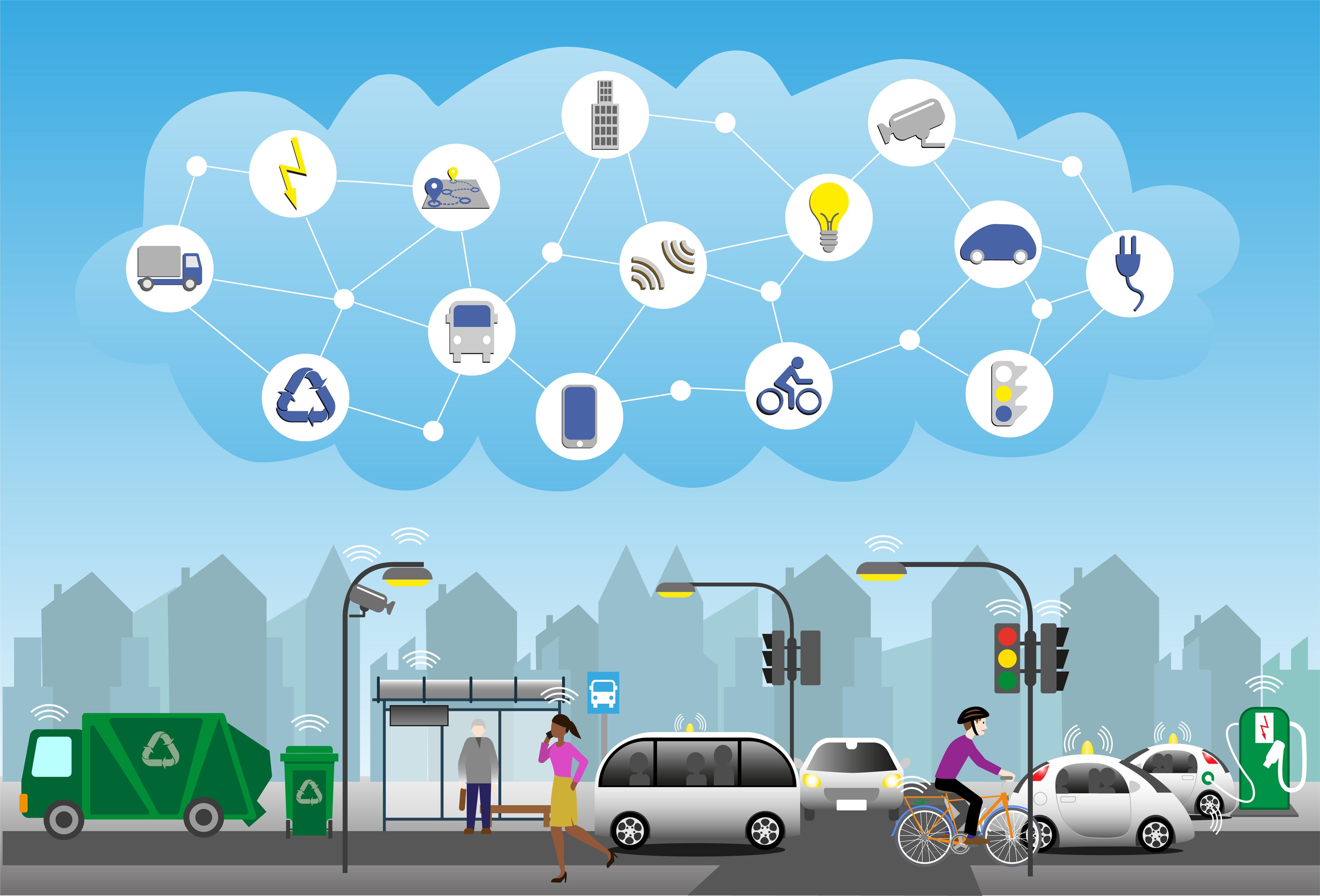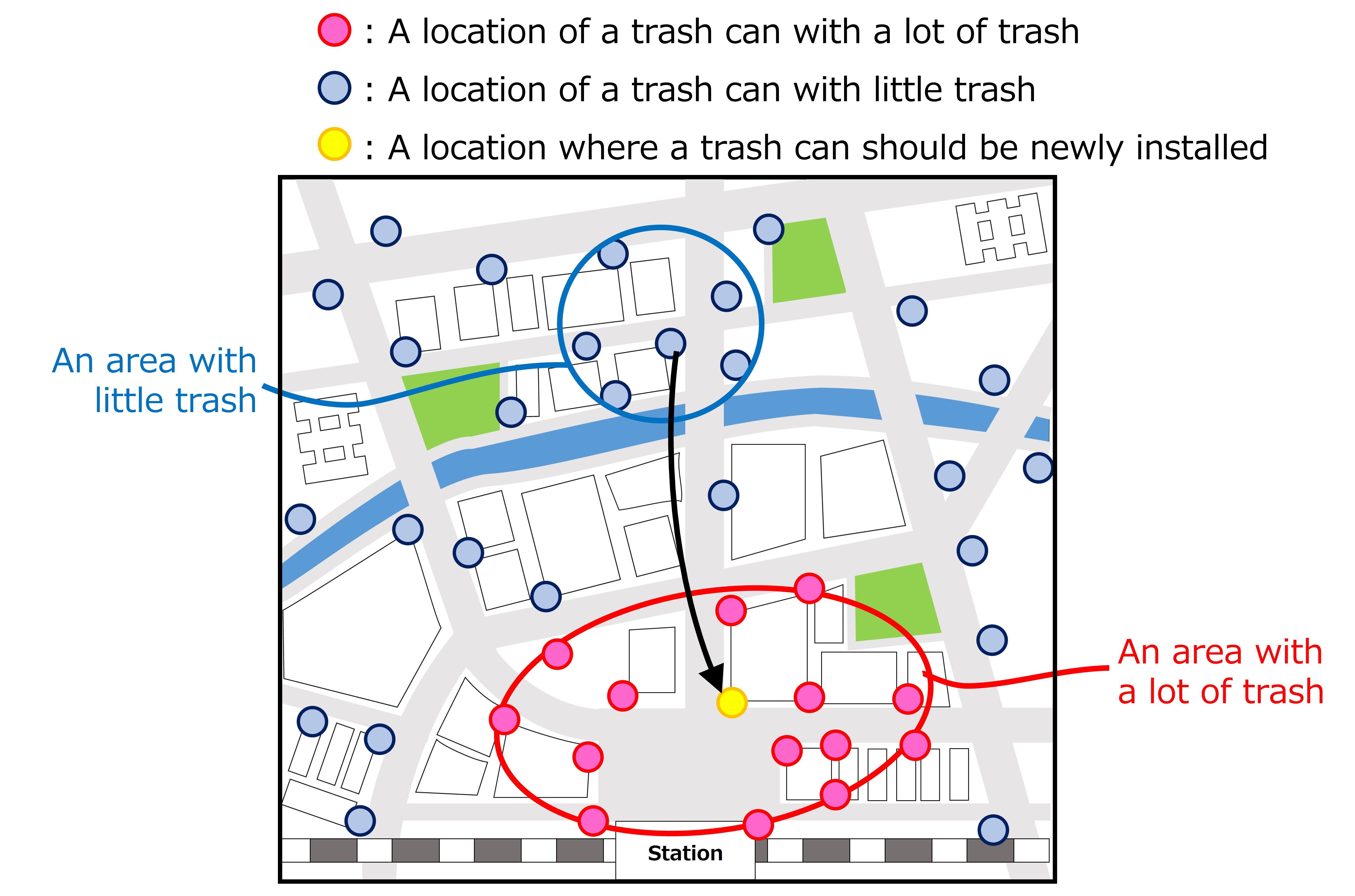Ideas for Using IoT Technology to Solve the Global Waste Problem

The Kyocera Group possesses a treasure trove of IoT technologies cultivated through the research and development of communication technologies as well as the development and design of communication modules. Using some creativity and imagination, we can turn these IoT technologies into services that will help build a better society and systems that will help protect the environment.
Aiming to play a greater role in society beyond our business, we are working to generate ideas for using IoT technologies in all sorts of ways.
Kyocera sees the global waste problem as an important social issue. We are looking for partners who will work with us on solutions to the waste problem since it is too big a task to tackle alone. Here are some of the patent applications that we would like to share.
Trash Can Placement Optimization System

Many people are uncomfortable with the sight of a full or overflowing trash can surrounded by trash.
This system combines location data with volume measurements from sensors installed inside trash cans in order to determine which areas have a large amount of trash and which areas have a small amount of trash.
Example 1
At one event site, sometimes the trash cans near the spectator area on the north side are full, while those near the spectator area on the east side are empty. For such an event site, this system can determine how many trash cans should be moved from the east side to the north side.
This system keeps track of how many times trash is thrown into a trash can by installing a sensor that detects when trash is thrown in. This system can also determine the remaining capacity of the trash can by installing a distance sensor that measures the distance between the topmost interior point of the trash can and the surface layer of the trash inside. Trash can placement may be optimized by using this information on trash volumes and location data so that trash cans are placed where the volume demands.
This system can also change the positions of trash cans according to the day of the week and the time of day by analyzing areas to determine which trash cans have a large amount of trash and which trash cans have a small amount of trash by both time and day.
Example 2
In some towns, the amount of trash may vary from one trash collection point to the other. For such towns, this system can suggest new collection points or new routes for servicing the collection points.
System for Tracking and Managing Product Points of Purchase and Points of Disposal

This system manages data collected when a product is purchased (date, time, place, etc.) in association with data collected when it is thrown into a trash can. This system can be useful for tracking the movement of products after they are purchased.
Example 1
Plastics are mostly made from a finite resource. Reusing them is a must for achieving a circular economy and reducing waste.
For example, most people throw away supermarket food trays after they are used. While many supermarkets already make efforts to collect and recycle these trays, they can increase the collection rate of these trays by using this system.
Supermarket operators can use the system to reward customers with points when they return used trays to a collection box installed at the store where they got it from. This will encourage customers to return to the same store. At the same time, supermarket operators can boost their collection rate for used trays and help protect the environment.
In order to encourage customers to visit their stores more frequently, supermarket operators can set a higher reward rate for customers who return used trays to the collection box shortly after purchase. This system can be used for more than just the waste problem.
This system can be used for more than just the waste problem.
Example 2
This system can also be used to monitor patients remotely.
A healthcare provider can verify that a patient has remembered to take their medicine or that the patient has taken it as prescribed, using a sensor installed in a trash can to read a tag attached to the medicine’s packaging.
This enables doctors to improve the health of their patients by instructing them on the proper use of medication.
Pub.No.US2023/0004995A1(PDF 479KB)
Trash Cans that Automatically Open/Close After Identifying Garbage

This system detects the type of trash being thrown away and opens/closes the corresponding trash can.
Example 1
When throwing a plastic bottle away, the trash can for recycling plastic bottles will open. When it is an aluminum can, the trash can for recycling aluminum cans will open. This will reduce the chance of trash being thrown into the wrong type of receptacle and improve the efficiency of sorting.
This system can be used for more than just the waste problem.
Example 2
This system allows for trash cans in the event venue to open only for trash related to products sold within the event venue. Tags are attached to the containers of products sold within the venue, and trash cans will only open for trash with one of these tags. On the other hand, this system prevents trash cans from opening when the trash to be thrown away has been brought into the venue.
This will help reduce the amount of trash brought into the event venue and encourage people to purchase products inside the venue, thereby helping to increase sales of products sold there.
Example 3
This system allows for trash cans to open only when a specific tag is attached to the trash. This prevents dangerous or suspicious items from being placed inside and makes the entire event venue safer.
Pub.No.US2023/0108985A1(PDF 397KB)
The above are just a few examples of Kyocera's innovative technologies. We believe that we can expand the applications of the above technologies across various industries through collaborations with a number of trusted business partners.
The Kyocera Group's IoT technology can also be applied to other areas. Check out the links at the bottom of this page.
Our IoT Technology
Telecommunications Devices (Kyocera Corporation)
Kyocera Corporation engages in research, development, and sales of telecommunications devices, as well as business support. Specifically, it focuses on devices that are relatively easy to install and operate as well as high-quality communication modules. Kyocera is meeting customer demand for high quality, speed, and efficiency when it comes to matching existing products and services with their needs and developing new products.
Telecommunication Services (Kyocera Communication Systems Co., Ltd.)
Kyocera Communication Systems Co., Ltd. provides wireless communication services such as LPWA and local 5G services. The company is engaged in integration, which includes the creation and utilization of community networks (specifically network design, construction, operation, and maintenance) and the provision of services for local residents through the synergy with its ICT business.
*This page is based on information available at the time of publication, and the status of patent rights and other industrial property rights may not be current.
Inquiries
Please contact us at the number below for inquiries about intellectual property.

